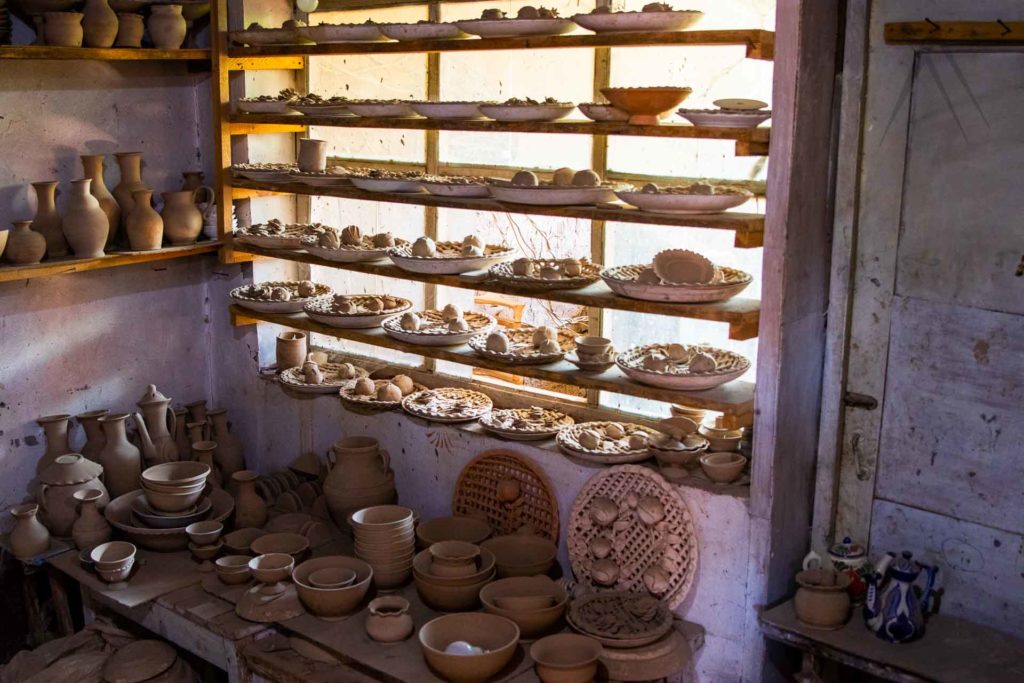Uzbek Ceramics
Uzbekistan ceramics culture
Ceramics (pottery) are one of the main applied arts in Uzbekistan. The first examples of the ceramics discovered in Uzbekistan date back to antiquity. During those ages, the unique expressiveness of the best of Uzbek ceramics has expressed the authentic artistic power of the nation. Found dishes, spherical cups, pialas (cups), vases, jugs, pots, and large and small khums, handy for use and at the same time, refined in form. Pottery and ceramics have existed a prominent role in the culture of the region and still are desired items for guests to bring back home. The works of the masters are distinguished by skilled workmanship, the beauty of form, unique ornaments, richly imaginative designs and a deep sense of the harmony of color.
Traditional centers of pottery have preserved through centuries the traditions and secrets in cities like Rishtan, Gijduvan, Khiva, Samarkand, Tashkent, Bukhara, and Khorezm. In Uzbekistan, pottery art integrated nomadic and farming culture, preserving the identity of the Uzbek people. During our Uzbekistan Tours and Central Asia Tours, there are several opportunities to admire and acquire Uzbek pottery.


Rishton Clay
Located in the Fergana Valley city of Rishtan is the oldest center of ceramic art in Central Asia. The pottery art of local artisans is known all around the world. Rishton ceramics differ in their shapes, ornaments, and colors. The most popular coloring of this pottery is a turquoise, dark blue, and brown scheme on a milky-white background. Ishkor glaze, made from ashes, gives the earthenware its beautiful soft shine.
Right at the entrance to the town, you can see a large vase welcoming to the capital of ceramics renowned in all Central Asia. Pottery stands in line just in front of the private houses. Guests in Rishstan can see the entire traditional process of making the ceramics by hand, including right from the start, when the unique local red clay transformed into the magnificent light blue color dish.
A wealth of local raw materials became one of the main reasons that shaped the development of pottery in Rishtan. Almost all of the components for the manufacturing of ceramic ware, from clay to dye, one could obtain on-site or nearby areas. The city itself has a reddish clay, which does not need in the pre-treatment and keeping. Some even dig their backyard to obtain the clay material.
Around the city, special herbs were collected for making “ishkorov glaze”, which gave a juicy emerald and turquoise inherent to Rishtan ceramics. Although that the composition of the glaze over the centuries has been remained unchanged, the masters, competing with each other, have their secrets in the ingredients, proportions and technologies.


Uzbek Ceramics creation
The creation of Uzbek ceramics goes through several steps. First, the proper clay must obtain: clean out any dirt, knead it and prepare it for the potter’s wheel. Next skilled artists practiced in particular types of ceramics set to work. Once a piece is ready, it is handed over to an artist who decorates it. A pattern is drawn onto the smooth surface of the piece, which is then dried, glazed and fired in a specially-constructed kiln.


Uzbek Ceramic patterns & their meaning
The patterns on the plates are never repeated, there are no two identical plates. Looking closer you can notice the characters for instance the picture of a jug means a symbol of hospitality, fish – a symbol of purity and wealth; birds – a symbol of peace and freedom; pomegranate, a symbol of wealth, abundance and fertility; Almonds, means luck, happiness and wealth and knives – a guard against evil.
Uzbek Ceramics workshops
Ceramics techniques, patterns and recipes are handed down through ancestors, but the twentieth century brought major changes to all aspects of life in Uzbekistan, and by the 1950s handcrafted ceramics were in decline as factory-made goods flooded the market. The traditional techniques were gradually forgotten, traditional patterns dropped out of use, and the recipe for “Ishkor” glazes was in danger of being lost. Many acclaimed workshops and centers closed their doors and the artisans’ children looked to other professions.
However some guilds and families managed to keep the old ways alive, and today Uzbek ceramics are enjoying a revival. Artisans in Rishtan, Gizhduvan, Shahrisabz, Urgut, Khiva and elsewhere are restoring time-honored techniques. Traditional patterns are popular once again, and vibrant, intricate ornamentations once more adorn the bowls and plates that grace tables both at home and abroad. Most workshops welcomes tourists. There you can watch all the stages of ceramics production, starting from preparation of clay, to hand shaping of various forms (plates, dishes, tureens), painting, drying and finally firing in kilns.


More about Uzbek culture
Page updated 30.5.2025